Acoustic Guitar Strumming Patterns
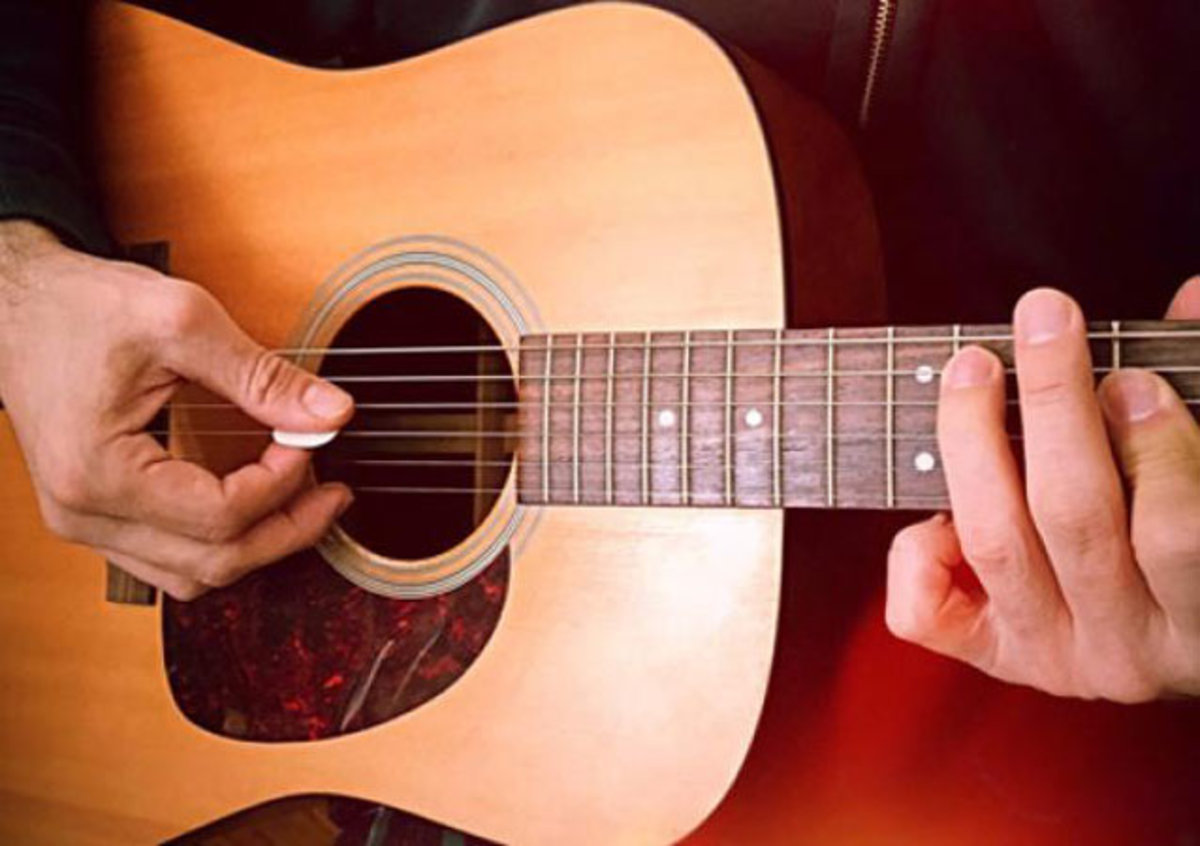
This is an abridged and shorter version of a lengthier article that can be found on Guitarchalk.com.
The acoustic and electric guitar handle differently. Some might say the acoustic guitar is made for strumming and rhythm, which—in some cases—is true. If that's your instrument of focus, then acoustic guitar strumming patterns become far more relevant and useful than if you're starting on the electric guitar.
Yet, strumming patterns are hard to comprehend. They're even more difficult to teach, because strumming patterns are based on rhythm.
Rhythm is something you feel and is better understood when absorbed intuitively and not only in an academic sense.
Some might say, "You either have rhythm or you don't."
TEACHING ACOUSTIC GUITAR STRUMMING PATTERNS
While that's true, there are ways to effectively teach strumming pattern basics, especially on the acoustic guitar. You can learn them in a way that allows you to practice the movements and get the "feeling" or intuition part of it down later.
Get The Pick Newsletter
All the latest guitar news, interviews, lessons, reviews, deals and more, direct to your inbox!
This article will explain acoustic strumming in the following ways:
- An explanation of time signatures in music theory and their role in guitar tabs
- Using quarter notes, eighth notes and pickstroke direction to build simple strumming patterns
- Subsequent work sheets that allow you to practice strumming patterns intentionally
This will give you a written explanation, the music theory background and a concrete way to practice acoustic guitar strumming. We'll start with the theory involved and how to use quarter and eighth notes to start learning basic rhythm within a 4/4 time signature.
Supplemental Strumming Pattern Video Course
Lisa McCormick covers all these topics in her Guitar Tricks Intro to Rhythm and Strumming course, which we'd recommend as excellent supplemental material. You can try it free for 14 days (cancel anytime) or use the promo code GUITARCHALK to get 20 percent off your first month.
Understanding Time Signatures and Strumming in Guitar Tabs
Strumming patterns are governed by time signatures, which can be identified in both sheet music and tablature. In most cases, you'll be playing in 4/4 time, which is also called "common" time. Here's how it would look in a guitar tab:
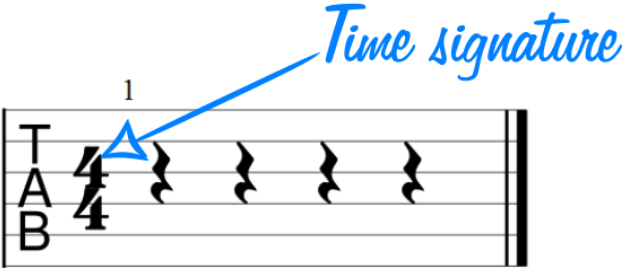
The first thing we need to do is make sure we know how to read and interpret 4/4 time or whatever time signature might be in that spot. Simply stated, 4/4 time means you have four quarter note beats within a single measure: One measure divided into four equally-timed parts. Thus, four quarter notes would complete the measure.
By the same token, two half note beats (1/2 + 1/2) would complete one measure of 4/4 time. You could also have varying arrangements of quarter and eighth notes. For example, you might have two quarter notes and four eighth notes within a measure.
Here's how four quarter note chords would look in a tab sheet:
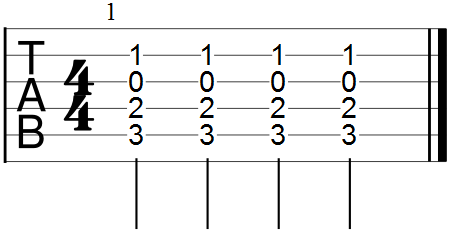
How does this apply to strumming patterns?
If you understand how to count through 4/4 time, your strumming can be as complex or as simple as you want it to be.
Strumming in 4/4 Time
To start strumming in 4/4 time you would first select a chord—say, open C major—then play through each quarter note by breaking up the root from the rest of the chord and giving each one an eighth note beat, like this:
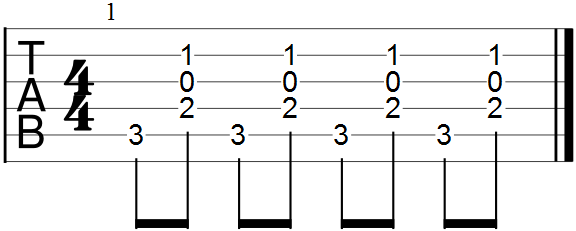
This follows a root/strum, root/strum sequence, giving you an easy first strumming pattern to work with, all within a single measure of music with four quarter note beats.
You could also just strum through the chord giving each one a single quarter note, as the prior tab sheet would indicate:
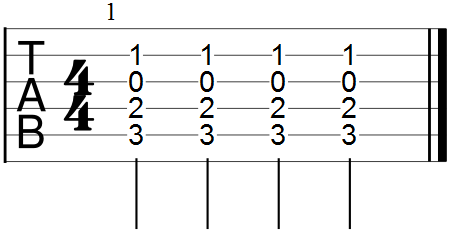
Adding Variation and Counting
Now that we can strum in 4/4 time with quarter notes and eighth notes, we can use downstrokes and upstrokes to create a more varied acoustic strumming pattern. By splitting each quarter note into halves, we get eighth notes that would be counted like this: [1 and][2 and][3 and][4 and]
This is the same amount of time, but is just making use of smaller units, since a single quarter note equals two eighth notes (as we covered previously). Here's what it would look like on a tab sheet with the accompanying count:
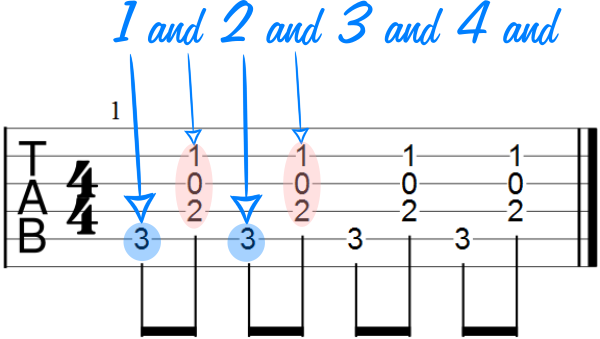
We need to make sure we're utilizing both a downstroke and upstroke as we strum. We go down on the 1, 2, 3, 4, but up on the "and" after each number. Here are the symbols used in tablature to indicate stroke direction:
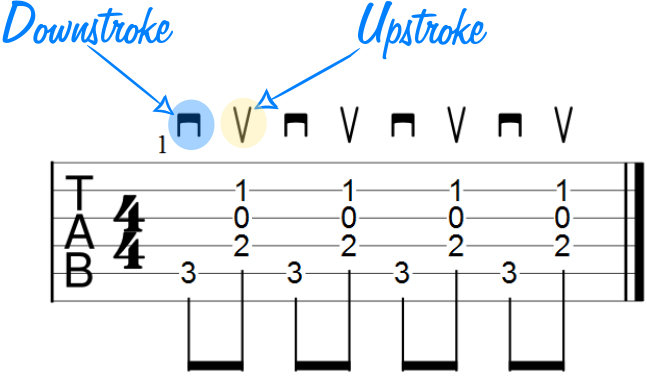
Lisa McCormick explains the details of this process in her Intro to Timing and Rhythm course.
TWEAKING THE STRUMMING PATTERN
At this point, you can inject some creativity and "flavor" into your strumming patterns by skipping certain pickstrokes. A good place to start is the eighth note pattern you were using before and skip the first "and." This means your upstroke in that instance would go past the strings but wouldn't touch them.
Here's what it would look like in diagram form:
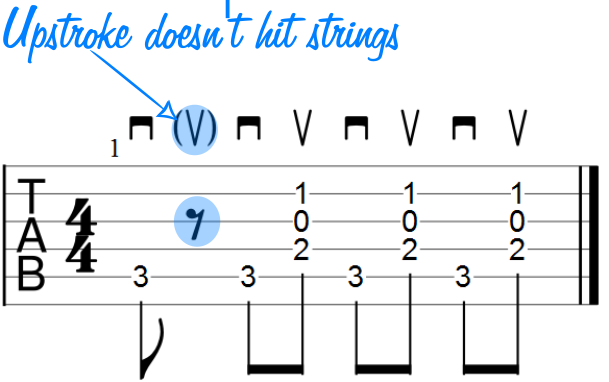
From here, you can begin to tweak and adjust your acoustic strumming patterns using different variations of this technique. Again, Lisa's video explanation on this is extremely helpful and gives voice to this in a more concrete and applicable way. You can checkout the video lesson here.
Acoustic Guitar Strumming Pattern Worksheets
We've gone through some crucial basics of acoustic guitar strumming, covering time signatures, quarter notes, eighth notes and pickstroke direction. In this section, I've set up a handful of worksheets that help you intentionally practice these strumming patterns and reinforce what you've already learned.
We'll do six worksheets total:
- Straight Quarter Note Strumming
- Straight Eighth Note Strumming
- Eighth Note Variation 1
- Eighth Note Variation 2
- Combo Variation 1
- Combo Variation 2
These will allow you to practice and utilize six different strumming patterns which will get more familiar as you practice them. From there you can build into more complexity and nuance as you get comfortable.
WORKSHEET #1: STRAIGHT QUARTER NOTE STRUMMING (DOWNSTROKE ONLY)
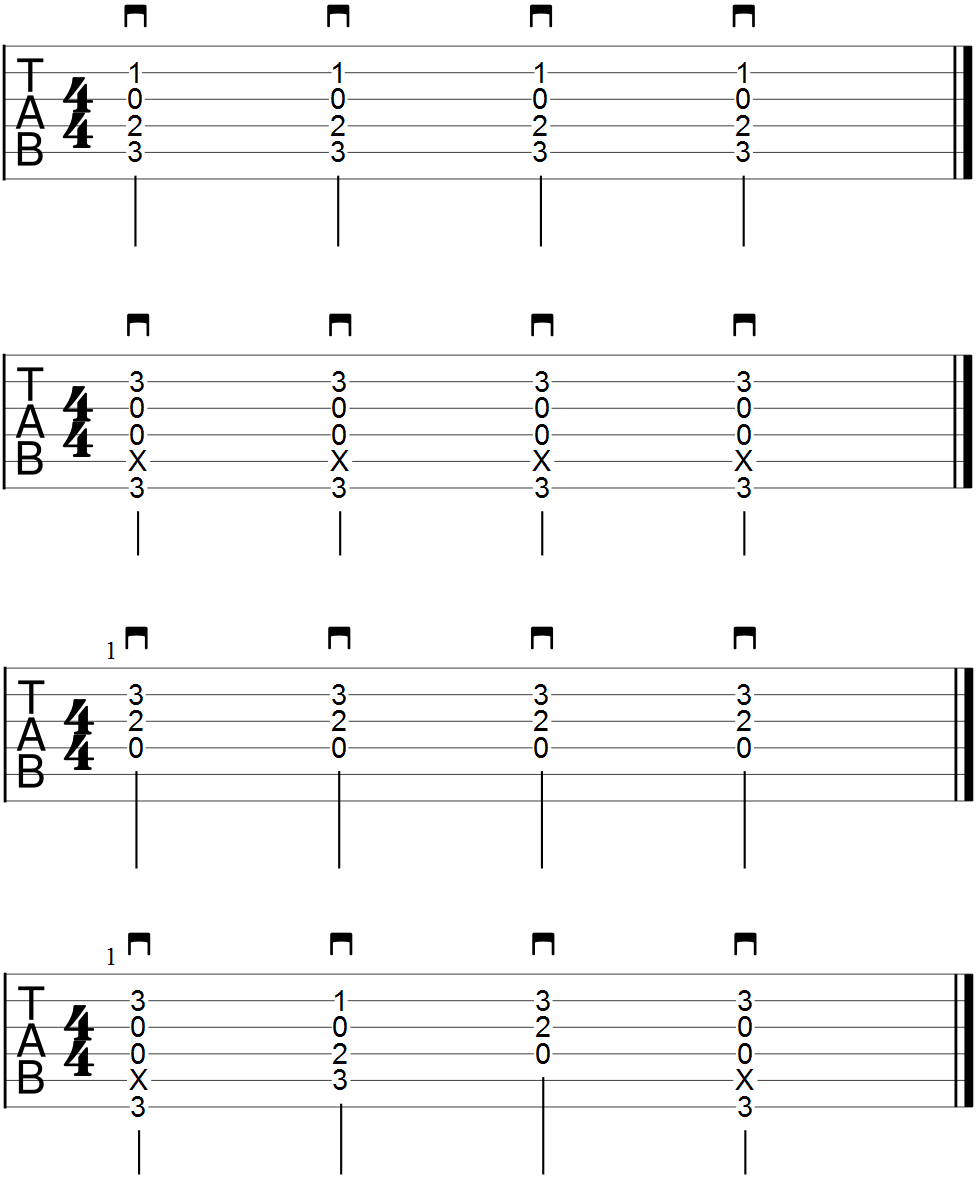
WORKSHEET #2: STRAIGHT EIGHTH NOTE STRUMMING (UP AND DOWNSTROKE)
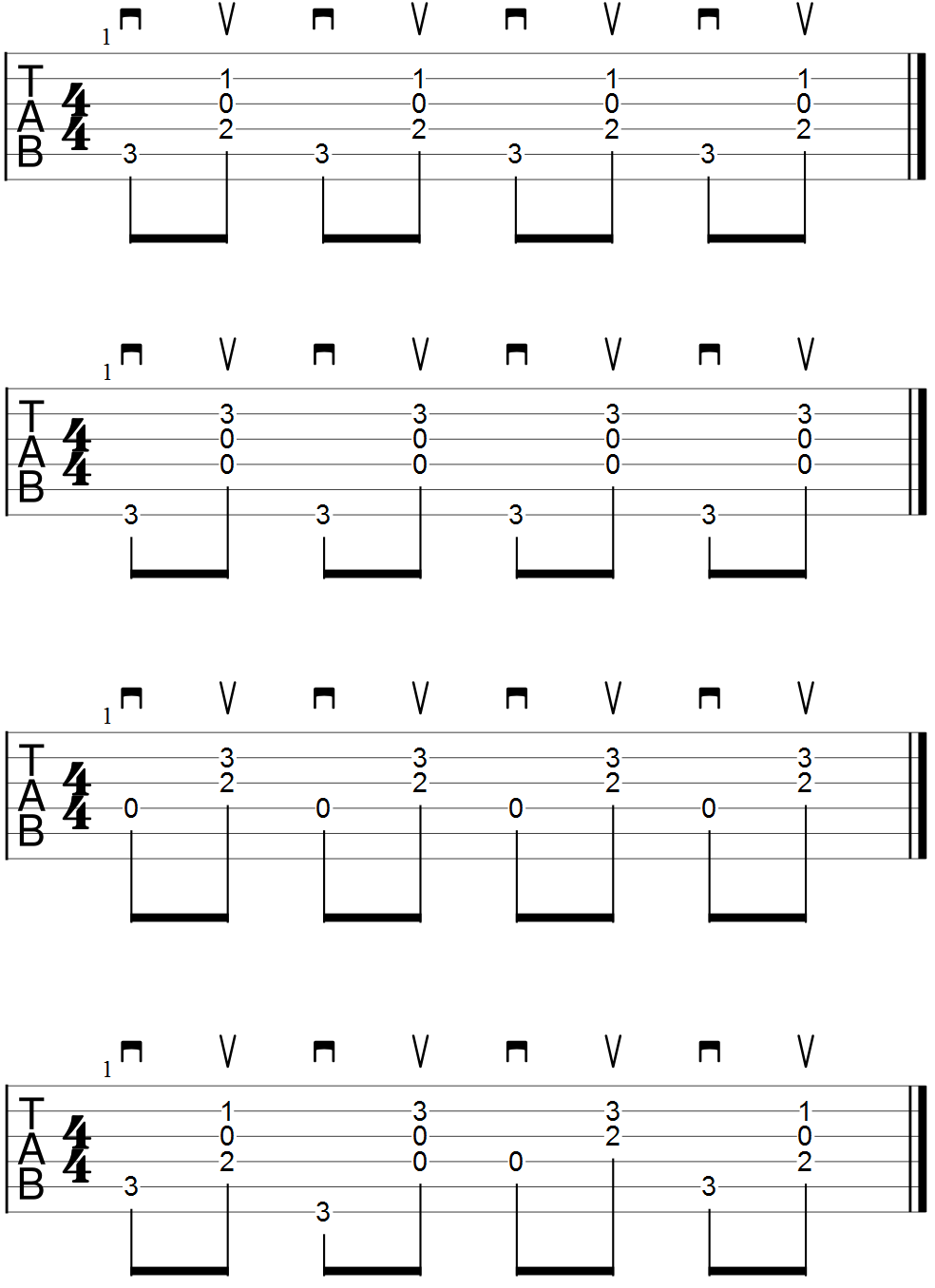
WORKSHEET #3: EIGHTH NOTE VARIATION 1

WORKSHEET #4: EIGHTH NOTE VARIATION 2

WORKSHEET #5: COMBO VARIATION 1

WORKSHEET #6: COMBO VARIATION 2

Reviewing and Recap
In this article we've covered all the necessary concepts to get familiar with basic strumming patterns. Conceptually we've gone over some theory, along with an explanation of the steps necessary to apply that theory.
Here's a quick review of each concept:
- Time signatures and quarter notes
- Splitting quarter notes into eighth notes
- Utilizing pickstroke direction
- Adding variance and nuance to straight strumming patterns
Once you understand the structure, it's easy to make small changes and leave out beats to create more unique and varied strumming patterns. The more comfortable you are with counting through quarter and eighth notes, the easier it will be for you to translate that count to the guitar.
Other Questions
If you have questions about the material in this lesson, feel free to drop them in the comments section below. I prefer interacting there (as opposed to email or social media) just because it provides more information for future readers who might have similar questions to ask.
Robert Kittleberger is the founder and editor of Guitar Chalk. You can get in touch with him here, or via Twitter, Facebook and Google Plus.
Bobby is the founder of Guitar Chalk, and responsible for developing most of its content. He has worked with leading guitar industry companies including Sweetwater, Ultimate Guitar, Seymour Duncan, PRS, and many others.
“For years, the only 12-string acoustics I got my hands on, the necks always pulled off after a bit. I earned a lot of money replacing them!” Why one of the UK’s most prolific luthiers is a bolt-on acoustic die-hard
“While the odd corner has clearly been cut, these are true Gibsons with all the individuality that this brand exhibits”: Gibson J-45 Special and Hummingbird Special review











